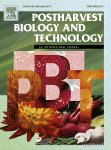Ver ítem
- xmlui.general.dspace_homeCentros Regionales y EEAsCentro Regional Entre RíosEEA ConcordiaArtículos científicosxmlui.ArtifactBrowser.ItemViewer.trail
- Inicio
- Centros Regionales y EEAs
- Centro Regional Entre Ríos
- EEA Concordia
- Artículos científicos
- Ver ítem
Biochemical characterization of the flavedo of heat-treated Valencia orange during postharvest cold storage
Resumen
Heat treatment is a powerful and eco-friendly method to prevent Penicillium infection in citrus fruit dur-ing the postharvest. Several studies have been dedicated to investigate the general chemical changes thatjustify the immediate reaction responsible for the induced tolerance; but just how primary metabolismand enzymology are affected by heat treatment and along a prolonged cold storage is still unclear. Inthis work, the main enzymes of carbon
[ver mas...]
Heat treatment is a powerful and eco-friendly method to prevent Penicillium infection in citrus fruit dur-ing the postharvest. Several studies have been dedicated to investigate the general chemical changes thatjustify the immediate reaction responsible for the induced tolerance; but just how primary metabolismand enzymology are affected by heat treatment and along a prolonged cold storage is still unclear. Inthis work, the main enzymes of carbon metabolism of Valencia orange flavedo were analyzed during thepostharvest period after a heat treatment (HT) of 48 h at 37◦C. Enzymatic activity measurements indi-cated that the NADPH producing enzymes glucose 6-phosphate dehydrogenase and non-phosphorylatingglyceraldehyde 3-phosphate dehydrogenase have lower levels in HT fruit. In parallel, a higher synthe-sis of sucrose from organic acids was observed in HT epicarp. Sucrose-phosphate synthase would havean important role in sucrose accumulation. The pathway of carbon through glycolysis was affected bycold storage, independently of HT, in a way that it favors the ATP-dependent phosphofructokinase overthe PPi-dependent homologous enzyme and the use of phosphoenolpyruvate (PEP) by PEP carboxy-lase instead of pyruvate kinase. Similarly, phenylpropanoid compounds did not show major changes inresponse to HT, although some of them showed a marked descent along the cold storage. Proteomic stud-ies revealed alterations in the abundance of ascorbate peroxidase, two germin-like proteins and smallHSPs, completing the description of the main metabolic changes in this tissue.
[Cerrar]

Autor
Perotti, Valeria Elisa;
Moreno, Alejandra Soledad;
Tripodi, Karina Eva Josefina;
del Vecchio, Hernán A.;
Meier, Guillermo Enrique;
Bello, Fernando;
Cocco, Mariángeles;
Vazquez, Daniel Eduardo;
Podesta, Florencio Esteban;
Fuente
Postharvest biology and technology 99 : 80–87. (2015)
Fecha
2015
ISSN
0925-5214
Formato
pdf
Tipo de documento
artículo
Palabras Claves
Derechos de acceso
Restringido
 Excepto donde se diga explicitamente, este item se publica bajo la siguiente descripción: Creative Commons Attribution-NonCommercial-ShareAlike 2.5 Unported (CC BY-NC-SA 2.5)
Excepto donde se diga explicitamente, este item se publica bajo la siguiente descripción: Creative Commons Attribution-NonCommercial-ShareAlike 2.5 Unported (CC BY-NC-SA 2.5)

